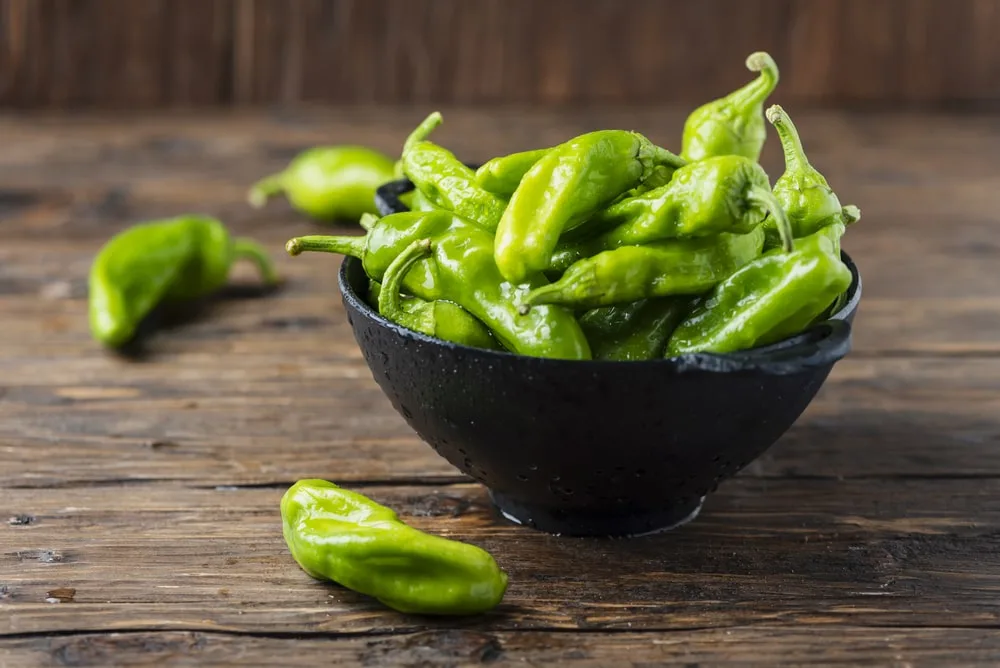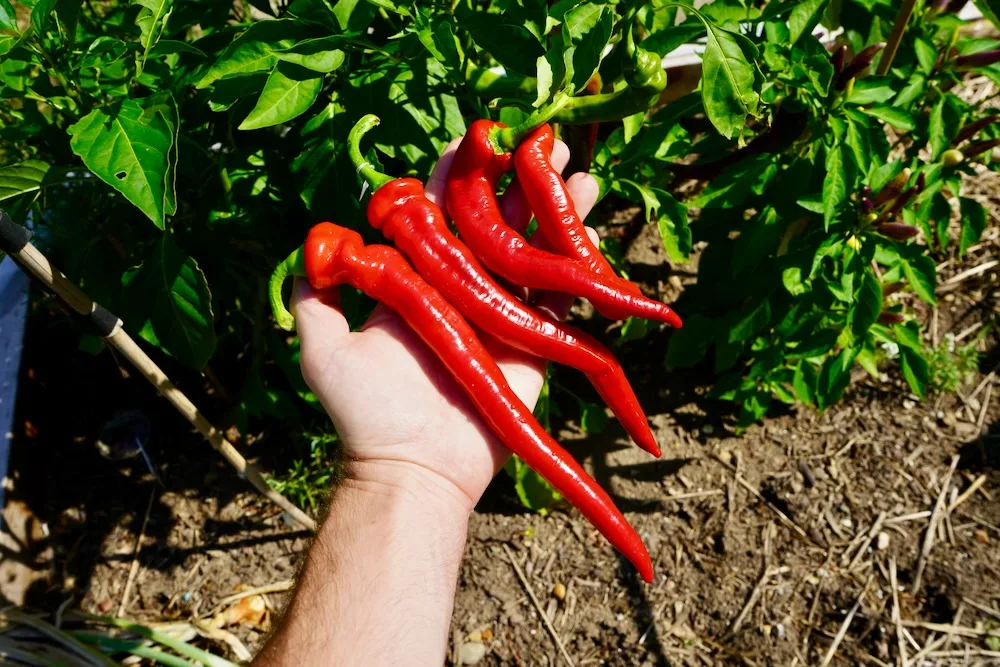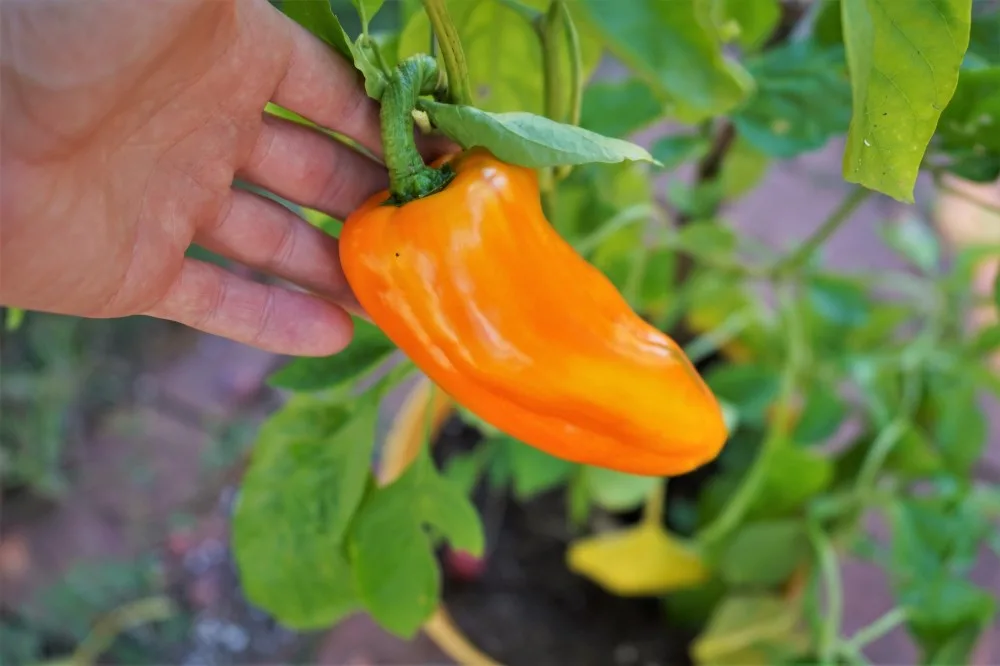Peppers first landed on Italian shores in the 1500s, likely coming from Northern Africa to Sicily. They went on to influence southern Italian cuisine for centuries.
Now, peppers are grown and used widely across the entirety of Italy (and Europe!). One of the descendants of the earliest peppers brought to Italy are friggitello peppers, and they are now widely available to eat and grow.

Friggitello peppers come from the species Capsicum annuum, home to the most popular varieties. These include bell, jalapeño, and cayenne peppers, among many others.
Like most Italian peperoncini, friggitelli are mild peppers. In fact, this variety has no heat at all, meaning that friggitello peppers are a purely sweet pepper variety.
Friggitello Pepper Characteristics
Different pepper varieties can have vastly different characteristics. Some plants produce many peppers, while others will only produce a handful. Here are a few quick details on the friggitello pepper:
Shape: Pendant, elongated
Color: Green, turning red when ripe
Length: 3-4 inches
Width: 1-1.5 inches
Heat level: 0 SHUs (no heat)
Harvest time: 70 days after transplanting
Plant height: 2-3 feet
Buy seeds: On Amazon

Given these characteristics, it makes a lot of sense that friggitelli are popular in Italy. Many people don’t like spicy food, so a sweet pepper is more accessible to the masses. In addition, the Friggitello plant produces lots of pepper pods, so growing them is more profitable for farmers.
Fun Fact: Peperoncini simply means ‘chili peppers’ in Italian. It is also a pepper variety that is commonly pickled in its unripe form.
Friggitello Pepper Scoville Rating
Since friggitello peppers have no heat at all, they register 0 SHUs on the Scoville scale. Other, closely related Italian peppers have mild heat levels, such as peperoncini peppers.
However, most Italian varieties are considered mild at just 100-500 SHUs on the Scoville scale. If more heat is needed, Italian chefs commonly use cayenne peppers in order to spice up tomato sauces and other dishes.
Friggitello Pepper Uses In Cooking
Friggitello peppers are widely used for appetizers (or antipasti). You may add them to a hearty stuffed pepper soup, or maybe fry them with tomato, garlic, and basil. Like any pepper, they are versatile and are large enough to be stuffed or ‘popped’ like jalapeños. They are also commonly used fresh in salads.
Friggitello peppers are heatless, which means that if you want your meal to be spicy, you’ll have to turn elsewhere. In Italian cuisine, the cayenne pepper is commonly used for this purpose, but you can pick from the long list of hot pepper varieties.
Other Italian Pepper Varieties
In North America, peperoncini (or pepperoncini) is well known as a pickled, light green pepper with mild heat. Often found in fresh salads at Italian and Greek restaurants, they add a nice tang.
However, the word peperoncino literally means ‘chili pepper’ in Italian. Here are a few other Italian pepper varieties available to buy or grow:
Jimmy Nardello
Truly one of our all-time favorite varieties, the Jimmy Nardello pepper has origins in Southern Italy. It eventually made its way across the Atlantic to New England, where it is still grown today (by us, in fact). This variety is long and bright red with a very sweet, almost fruity flavor. Perfect for frying or eating straight from the garden. Get seeds here.

Marconi
Marconi peppers are among the largest Italian varieties. These are commonly considered an alternative for bell peppers, as they are big enough to be stuffed. Deliciously sweet and crunchy, and they come in a variety of colors.

Peperoncini Peppers
Likely the most common of all Italian peppers, the peperoncini pepper has a mild heat level and a tangy, savory flavor. With significantly less heat than even a jalapeño pepper, the peperoncini is palatable to most.
There is a reason this pepper variety shares its name with the word for ‘chile pepper’ in Italian! A true classic, commonly used for pickling when the peppers are underripe. Try growing them with seeds here.
Golden Greek (Friarelli)
Difficult to find, though some say they are very similar to Japanese shishito peppers. If you are struggling to find this pepper, shishitos seem like a safe substitute. Friarelli peppers have a mild heat level and grow to be up to 5 inches in length. Great for frying while green, pickling, or even stuffing.
How To Pickle Friggitello Peppers
Pickling peppers is perhaps our favorite method for preservation. Friggitellos (and all other peperoncini) are commonly pickled whole. If you’re looking for an authentic, simple method, use these instructions. For a more detailed method for pickling peppers, read our article on pickling jalapeños here.
Ingredients:
- Friggitello peppers
- 3 cups white vinegar
- 1 cup water
- 2 Tbsp kosher salt
How To Pickle Friggitello Peppers
- Choose slightly unripe peppers.
Traditionally, peperoncini are pickled before they reach full ripeness (while the peppers are still green). This is not necessary, but green peppers have a more tart flavor.
- Clean peppers.
Rinse the peppers under cool water. Dry.
- Poke the peppers with a fork.
Pierce the peppers slightly with a fork. Don’t go overboard, just enough to allow the vinegar mixture to seep into the pepper’s skin.
- Add peppers to glass jars.
Fill the jars to about an inch from the top, packing them in tightly. You can remove the stems if desired, but they are typically left on.
- Boil vinegar, water, and salt.
Bring the vinegar, water, and salt to a light boil in a pot. Shut off the heat once it begins boiling.
- Pour hot vinegar over friggitelli.
Pour the hot liquid over the peppers in the jars. Leave about 1/2 inch of headspace, and mix peppers to allow any trapped air to release.
- Seal jars with metal lids and refrigerate.
Seal the jars and refrigerate for up to 6 months. The peppers will soften over time, so it is best to use them soon, or add a pickle crisper for long term storage. The vinegar is highly acidic, acting as a preservative for the fresh peppers.
Friggitello peppers may not be a household name in North America, but in Italy, these peppers are part of history. They are part of a tightly-knit family of Capsicum annuum peppers that date back to the introduction of chilies in Italy. Friggitellos and other peperoncini have a growing place in Greek and Italian food, and here at Pepper Geek, we love them too!

